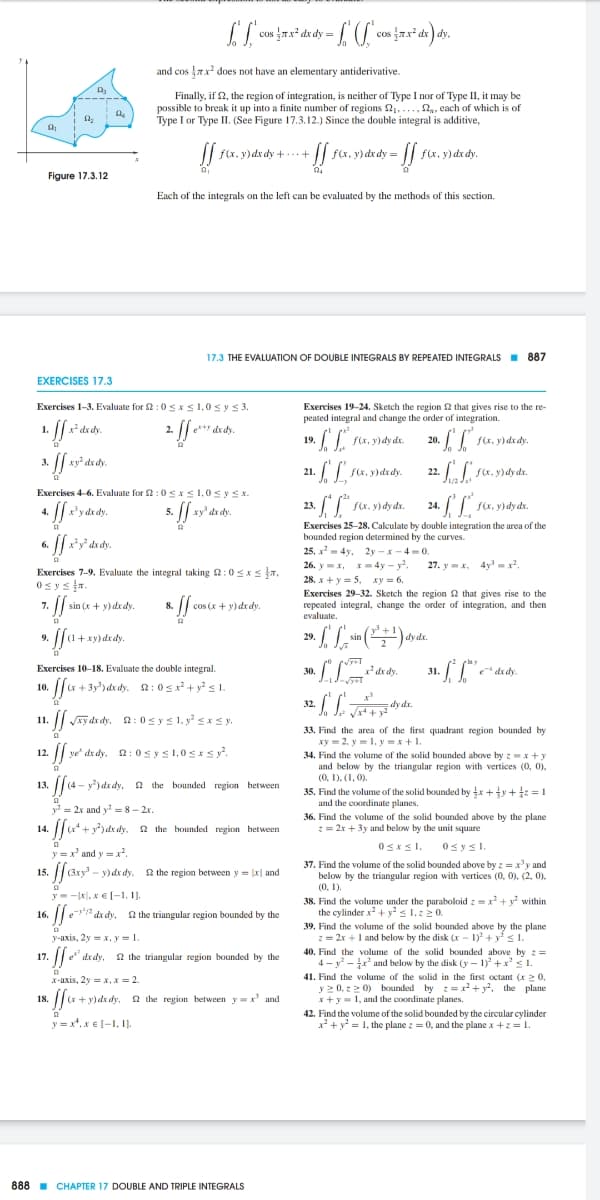Calculus: Early Transcendentals
8th Edition
ISBN:9781285741550
Author:James Stewart
Publisher:James Stewart
Chapter1: Functions And Models
Section: Chapter Questions
Problem 1RCC: (a) What is a function? What are its domain and range? (b) What is the graph of a function? (c) How...
Related questions
Question
100%

Transcribed Image Text:cos ax
and cos 7x does not have an elementary antiderivative.
Finally, if 2, the region of integration, is neither of Type I nor of Type II, it may be
possible to break it up into a finite number of regions 21,..
Type I or Type II. (See Figure 17.3.12.) Since the double integral is additive,
2, each of which is of
f(x, y)dx dy +...+
f(x, y) dx dy =
f(x, y) dx dy.
Figure 17.3.12
Each of the integrals on the left can be evaluated by the methods of this section.
17.3 THE EVALUATION OF DOUBLE INTEGRALS BY REPEATED INTEGRALS I 887
EXERCISES 17.3
Exercises 1-3. Evaluate for 2 :0 s x < 1,0 s ys 3.
Exercises 19-24. Sketch the region 2 that gives rise to the re-
peated integral and change the order of integration.
x* dx dy.
e+ de dy
f(x, y) dy dx.
f(x, y) dx dy.
19.
21.
f(x, y)dx dy.
f(x. y)dy dx.
Exercises 4-6. Evaluate for 2:0sxs1,0sy s x.
23.
S(x, y) dy dx.
24.
fx. y)dy dr.
4.
Exercises 25-28. Calculate by double integration the area of the
bounded region determined by the curves.
25. x = 4y, 2y - x -4 = 0.
26. y -x, x- 4y - y.
28. x + y = 5, xy = 6.
Exercises 29-32. Sketch the region 2 that gives rise to the
repeated integral, change the order of integration, and then
evaluate.
6.
x*y* dx dy.
27. y =x, 4y-x.
Exercises 7-9. Evaluate the integral taking 2:0sxs fT,
0systr.
sin (x + y) dx dy.
cos (x + y) dxdy.
9.
+xy) dx dy.
Exercises 10-18. Evaluate the double integral.
30.
31.
+ 3y')dx dy. 2: 0sx² + y? < 1.
10.
dy dz.
|| JAy dx dy, a:0 s y s 1. y? sx s y.
11.
33. Find the area of the first quadrant region bounded by
xy = 2, y -1, y
34. Find the volume of the solid bounded above by z-x +y
and below by the triangular region with vertices (0, 0),
(0, 1). (1, 0).
35. Find the volume of the solid bounded by x +ty + = 1
and the coordinate planes.
yx+ 1.
|| ve' de dy. 2:0sys 1,0 sx s y.
12.
13.
2 the bounded region between
y= 2x und y = 8 – 2x.
36. Find the volume of the solid bounded above
the plane
2 the bounded region between
2 = 2x + 3y and below by the unit square
14.
y = x' and y = x,
0sx <1,
Osysi
37. Find the volume of the solid bounded above by z = x'y and
below by the triangular region with vertices (0, 0), (2, 0).
(0, 1).
15.
y)dx dy.
2 the region between y= x| and
y--Ixl, x € (-1, 1).
38. Find the volume under
paraboloid z-x²+ y within
·// * dx dy, a the triangular region bounded by the
the cylinder x + ys 1,z20.
16.
y-axis, 2y = x, y = 1.
39. Find the volume of the solid bounded above by the plane
2 = 2x +1 and below by the disk (x - 1) + y< 1.
40. Find the volume of the solid bounded above by z=
4 - y - r and below by the disk (y – 1 +x1.
41. Find the volume of the solid in the first octant (x 2 0,
y 2 0, z 2 0) boounded by z= + y, the plane
x+y = 1, and the coordinate planes.
· || " dx dy, 2 the triangular region bounded by the
17.
x-axis, 2y = x,x = 2.
J« + y)ds dy, 2 the region between y=x' and
y = x*.x € [-I, 1).
18.
42. Find the volume of the solid bounded by the circular cylinder
x* +y* = 1, the plane z = 0, and the plane x + = 1.
888 - CHAPTER 17 DOUBLE AND TRIPLE INTEGRALS
Expert Solution
This question has been solved!
Explore an expertly crafted, step-by-step solution for a thorough understanding of key concepts.
This is a popular solution!
Trending now
This is a popular solution!
Step by step
Solved in 2 steps with 1 images

Knowledge Booster
Learn more about
Need a deep-dive on the concept behind this application? Look no further. Learn more about this topic, calculus and related others by exploring similar questions and additional content below.Recommended textbooks for you

Calculus: Early Transcendentals
Calculus
ISBN:
9781285741550
Author:
James Stewart
Publisher:
Cengage Learning

Thomas' Calculus (14th Edition)
Calculus
ISBN:
9780134438986
Author:
Joel R. Hass, Christopher E. Heil, Maurice D. Weir
Publisher:
PEARSON

Calculus: Early Transcendentals (3rd Edition)
Calculus
ISBN:
9780134763644
Author:
William L. Briggs, Lyle Cochran, Bernard Gillett, Eric Schulz
Publisher:
PEARSON

Calculus: Early Transcendentals
Calculus
ISBN:
9781285741550
Author:
James Stewart
Publisher:
Cengage Learning

Thomas' Calculus (14th Edition)
Calculus
ISBN:
9780134438986
Author:
Joel R. Hass, Christopher E. Heil, Maurice D. Weir
Publisher:
PEARSON

Calculus: Early Transcendentals (3rd Edition)
Calculus
ISBN:
9780134763644
Author:
William L. Briggs, Lyle Cochran, Bernard Gillett, Eric Schulz
Publisher:
PEARSON

Calculus: Early Transcendentals
Calculus
ISBN:
9781319050740
Author:
Jon Rogawski, Colin Adams, Robert Franzosa
Publisher:
W. H. Freeman


Calculus: Early Transcendental Functions
Calculus
ISBN:
9781337552516
Author:
Ron Larson, Bruce H. Edwards
Publisher:
Cengage Learning